- By Kevin Cureau
Understanding the beauty of A. Lange & Söhne also means understanding its origins and the continued legacy of the Lange family. The painstaking craftsmanship and innovation that the maison displays to this day can be traced back to its founder Ferdinand Adolph Lange.
The Beginnings
The story of the German watchmaking maison A. Lange & Söhne takes place in two parts and in two vastly different times of the World’s history. The first part starts with the birth of Ferdinand Adolph Lange in 1815 in Dresden, Germany. After studying at the Technical College in Dresden, F. A. Lange becomes an apprentice with watchmaker Johann Christian Friedrich Gutkaes. Under his tutelage, Lange would reveal himself as a fine craftsman with extensive intelligence and a dedicated work ethic. His travels would then bring him to Paris, France in 1837, then the hub of precision watchmaking, where Ferdinand Adolph Lange would be the factory foreman in a leading watch workshop led by Austrian watchmaker Joseph Thaddeus Winnerl (inventor of the split-second chronograph mechanism). There he would refine his skills as a watchmaker while at the same time studying astronomy and physics at the Sorbonne.
Upon his return to Dresden in 1841, F. A. Lange is already showing an impressive body of work and an approach to issues of timekeeping that puts him ahead of his time. He decides to replace the watchmaking measuring system known as the Paris ‘lignes’ into the much more practical metric system. He also takes part in the construction of the famous five-minute clock sitting in the Semper Opera House, which displays the time digitally, high above the stage, using two rotating barrels. This clock would of course provide the inspiration for the large date window that is the signature of A. Lange & Söhne watches today.
With the help of the local Saxon government, F. A. Lange establishes A. Lange & Cie and opens his own workshop in Glashütte on December 7, 1845 with the aim of training 15 apprentice watchmakers and bringing work to the impoverished region. For nearly 30 years, Lange does pioneering work in various areas and revolutionizes fine watchmaking. He introduces the principle of division of labour where every specialist watchmaker is responsible for a specific step of the manufacturing process. He improves tools, introduces the metric system in the workshop, and most importantly develops the famed three-quarter plate; a now iconic signature of watches from Glashütte.
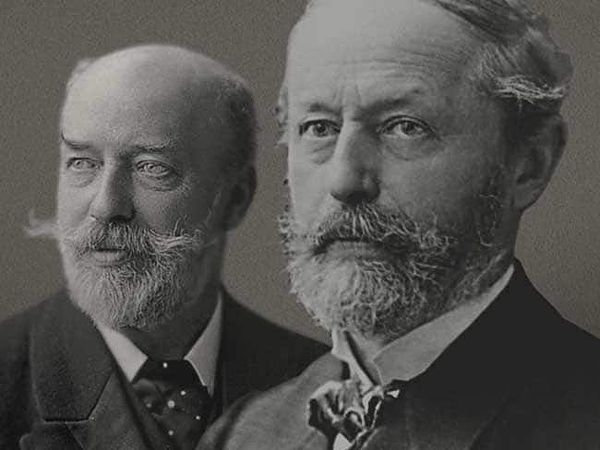
Emil and Richard Lange
In the late 1860’s and early 1870’s, Lange’s sons Richard and Emil join their father’s company, changing the name to A. Lange & Söhne (A. Lange & Sons). After the passing of F. A. Lange in 1875, the two brothers continue to establish the brand as a leading watchmaker, creating exquisite and beautifully decorated pocket watches which are highly appreciated by royalty; the unique piece GRAND COMPLICATION no. 42500, to this day one of the most technically complex timepieces ever built by the brand; the scientific pocket chronometer, and also observation watches. The company stays in the family with Richard Lange’s nephews Otto, Rudolf and Gerhard Lange guiding the company.

Sadly the World Wars were not kind to the brand and the town of Glashütte. The company’s main production building is destroyed in a bombing on the last night of the war in 1945 and the following Soviet occupation leads to the expropriation of all the watchmaking companies present in Glashütte in 1948. The A. Lange & Söhne brand disappears.
A. Lange & Söhne’s Revival
Born in 1924, Walter Lange, the son of Rudolf Lange, grandson of Emil and great-grandson of Ferdinand Adolph Lange, is destined to be a watchmaker. The many hours spent with his father in the watchmaking workshops as a young boy leads him to attend the renowned watchmaking school in Karlstein in Austria’s Waldviertel region in 1941. As World War II progresses and derails the life he had planned, Walter Lange is forced to flee to West Germany where he would have to wait patiently for the moment he can make his dream come true: relaunching the family business.
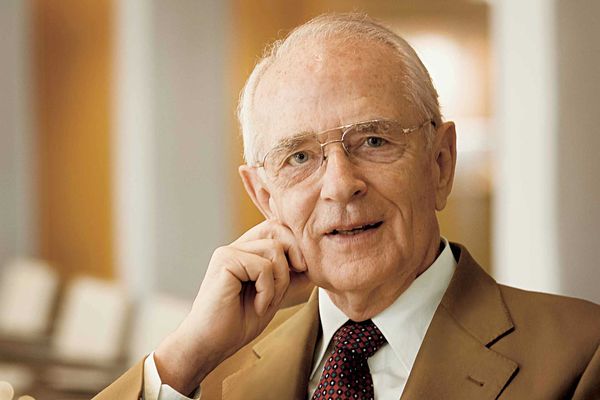
The second part of A. Lange & Söhne’s story takes place immediately after the fall of the Berlin wall in 1989. The German reunification provided Walter Lange with the opportunity to reestablish the A. Lange & Söhne name and end the involuntary hiatus of more than 40 years for the brand. Symbolically, Lange chose the date of December 7, 1990 to re-register the company name, 145 years after his great-grandfather had started the business.
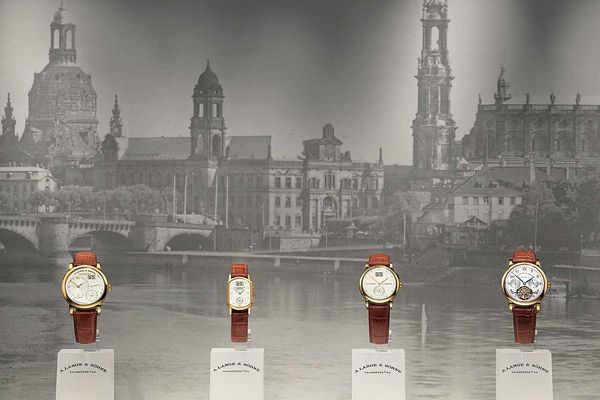
With the help of Günter Blümlein, arguably one of the most important figures of the watch industry, a plan is etched to revive Lange’s family business. Their presentation of A. Lange & Söhne’s new watch collection on October 24th, 1994 would be known as a landmark event launching the brand immediately at the forefront of high-end luxury watchmaking.
The history of A. Lange & Söhne, from its beginnings to its revival, already places the manufacture inside a philosophy driven by passion, craftsmanship, and a family legacy. It is not hard to understand why Walter Langer was eager to continue in the footsteps of his greatgrandfather; anyone would if they had such a prestigious family provenance.
Beauty and Quality at its Core
The annual watch production of A. Lange & Söhne is said to be around 5000 timepieces. It is still very much a niche brand and one that is mainly appreciated by knowledgeable collectors. You have to be a bit of a connaisseur to fully understand and appreciate the fine work done at A. Lange & Söhne.

There is a certain German approach to legibility and design, which puts importance on what you have to see first and what you have to see second in their timepiece. The dials are highly legible and very much understated, but when you turn the watch over it is the opposite; it’s opulent, highly decorated, it’s everything collectors want to indulge themselves in. It is their definition of what German high-end watchmaking should be.
A signature of A. Lange & Söhne timepieces is the hand-engraved balance cock. From the simplest time-only watch to the highest of complications, every Lange watch features this attribute. Just like human hand-writing, nothing is identical and each engraver has its own interpretation of the flowery design present on the balance-cock. You could then get away with saying that each A. Lange & Söhne is a unique piece.
To examine, understand and fully appreciate the craftsmanship that goes into Lange timepieces, we’ll take a look at some of the lots offered in the upcoming Hong Kong Watch Auction: X
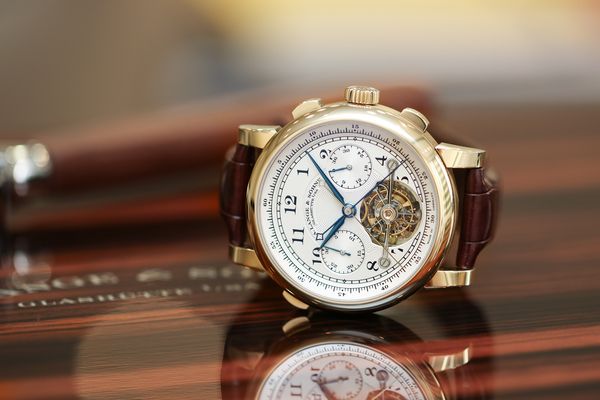
Lot 816 - Tourbograph ‘Pour le Mérite’ Ref. 712.050
The maison’s commitment to haute horlogerie and innovation is seen from the get-go when A. Lange & Söhne introduced the four timepieces that would constitute the re-launch collection of the brand in 1994.
One of the timepieces presented was the Tourbillon ‘Pour le Mérite,’ Lange’s first new-era tourbillon watch. ‘Pour le Mérite’ (PLM) timepieces still occupy an important place in the brand’s catalog and they are all united by one technical mechanism which was never before implemented in a wristwatch this way: the fusée-and-chain. The extremely complex structure provides more constant force to the escapement through the duration of a watch's power cycle. The cone-shaped component, designated as the fusée, is connected to the mainspring’s barrel by a chain. As the watch’s power decreases throughout the day, the tension from the fusée’s chain on the barrel ensures that a consistent amount of energy is released through the movement until there is none left.
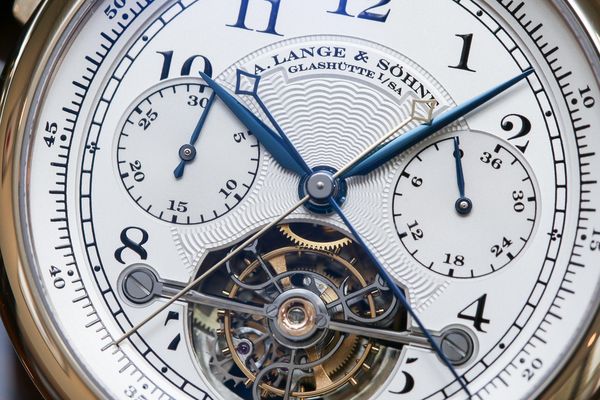
Launching such a timepiece as part of the new era of watches from A. Lange & Söhne, and in 1994 nonetheless, sent a clear message to the industry; they were not playing around and were positioning the maison as a powerful producer of well-crafted high-end timepieces. And they pursued in this direction in 2005 with the release of the second PLM timepiece; the Tourbograph "Pour le Mérite,” the first wristwatch by any manufacturer to incorporate a one-minute tourbillon, a rattrapante chronograph, and the fusée-and-chain mechanism, all at the same time, in the
confined space of a wristwatch; an amazing technical achievement which makes the Tourbograph an extraordinary mechanical opus.
The highlight lot of the A. Lange & Söhne selection from the Hong Kong Watch Auction: X is arguably lot 816, the A. Lange & Söhne Tourbograph “Pour le Mérite” in the maison’s proprietary 18K Honey Gold, which showcases a warm hue of “honey” with a hardness tougher than platinum. It was produced in a limited edition of only 50 pieces and only for one year between 2010 and 2011. This is highly attractive for collectors who love to find these references produced only for an extremely short period of time. Adding to its attraction, the present example is presented in excellent overall condition with very limited wear and accompanied by the full set of accessories.
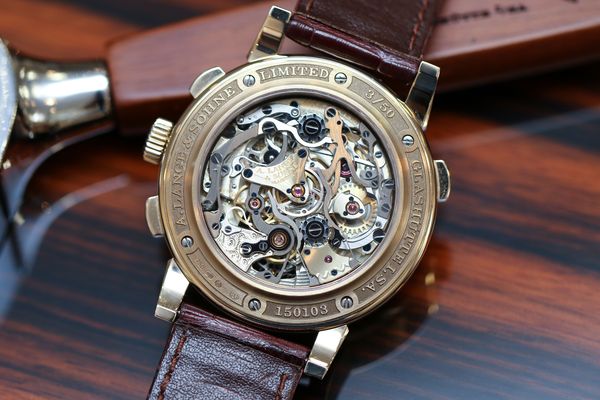
2010 marked the 165th anniversary of Ferdinand Adolph Lange’s move to Glashütte. A. Lange & Söhne honoured his spiritual heritage, as the founder of German precision watchmaking, with a collection of three timepieces which this Tourbograph “Pour le Mérite” was part of. The collection was also the one which premiered the maison’s new gold alloy of unprecedented hardness with a new hue: the 18-carat Honey Gold.
With a timepiece like this, it is not hard to understand why Lange is a brand loved by real watch connaisseurs. The firm is most famous for their fathomable craftsmanship in movement architecture and finishing, and people often like to compare their movements to “tiny cities.” This saying is clearly on display here with the depth and layers that the sophisticated in-house caliber L903.0 contains. With over 1,000 individual components assembled to achieve such feat, the meticulous fusée-and-chain transmission alone comprises 636 parts assembled in the likes of a bicycle chain.
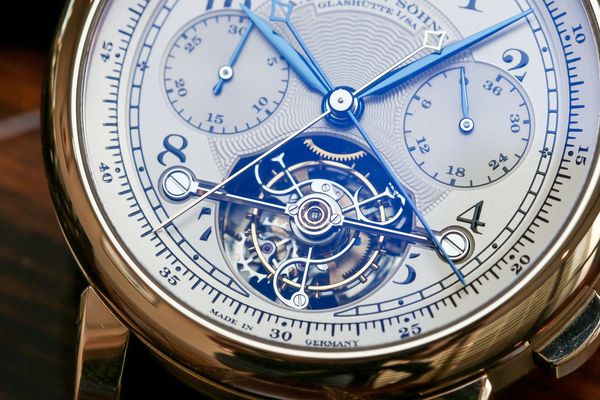
The tourbillon escapement consists of 84 components alone, however weighing exceptionally light at approximately 0.5 grams. The finishing is exquisite and Lange also finishes to the highest level the parts of the movement which are invisible to the wearer, such is the dedication of the brand to their craft. It is worth noting as well that all movements at A. Lange & Söhne are double assembled; meaning that all the components are put together a first time to guarantee perfect function, then they are disassembled for decoration, and then reassembled again for the final verification before being delivered.
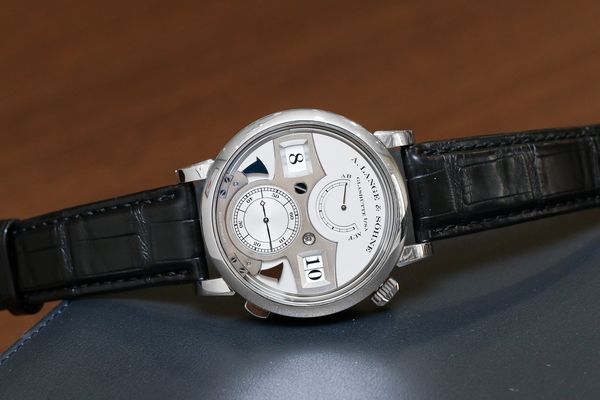
Lot 967 - Zeitwerk “Striking Time”
From its beginnings, A. Lange & Söhne has been at the forefront of technical advancements and precision quality timing. Their 2009 release of the Zeitwerk model with digital display was not only a game changer for its creative design but also for its technical craftsmanship.
There aren’t many timepieces on the market which feature a digital display of the time like the Zeitwerk does, because of the complex mechanism required to show that information in two large aperture windows. Incidentally, the inspiration for the Zeitwerk was to pay homage to the Dresden Semper Opera and its house clock with a five-minute digital display.
The Zeitwerk needs to move three discs to show the time digitally, a large one for the hours and two smaller discs for the tens of minutes and the minutes. These discs need to jump forward perfectly throughout the day so needless to say that a large amount of power is required to move these discs around. To solve this, the Zeitwerk uses a constant force mechanism (remontoire d’égalite) between the barrel wheel and the balance, enabling an even flow of energy to power the jumping hour and minute discs of the “time bridge” display throughout its 36 hours of power reserve.
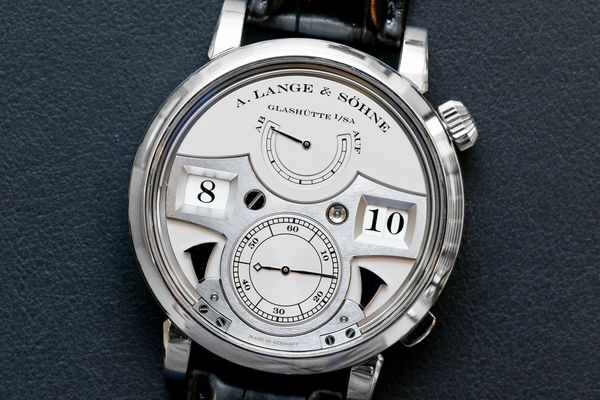
Removed from the brands traditional time only, chronograph and perpetual calendar timepieces, the Zeitwerk is a contemporary watch one may have assumed was produced by an independent maker, and while it is hard to improve upon the model, A. Lange & Söhne did so in 2011 when the German maison released the Zeitwerk Striking Time, adding a new dimension to the collection. It was also the first chiming watch from A. Lange & Söhne in its new era.
Called a “resonant masterpiece” by A. Lange & Söhne, the Zeitwerk Striking Time features the familiar three disc “time bridge”, however it now has acoustic gongs striking the quarters and hours, making it the world’s first mechanical wristwatch with jump display and visible striking mechanism. The hour is struck with a low pitch tone via the left hammer, while the quarters are struck on the right hammer producing a high pitched tone. A hybrid petite sonnerie, this is a complex and superlative wristwatch that is all original, but deeply rooted in the brand's history.

The present example made in a limited edition of 100 in platinum is in excellent overall condition and accompanied by its warranty and presentation box.

The Zeitwerk Striking Time occupies an important place in the Zeitwerk collection as it provided the canvas for the brand to see if their watchmakers could take on the challenge of adding a chiming function, which requires a significant amount of power as well, to an already demanding time jumping complication. Their success is what paved the way for the other chiming watches in the collection; the Zeitwerk Minute Repeater and the Zeitwerk Decimal Strike.
It would be easy to dismiss the Zeitwerk, and its various iterations, as a “simple” watch, but the beauty of Lange timepieces is that they indeed require watchmaking knowledge and a deep appreciation of the challenges that the brand overcomes to animate such a watch flawlessly, while still establishing it as a useful and casual daily wearer.
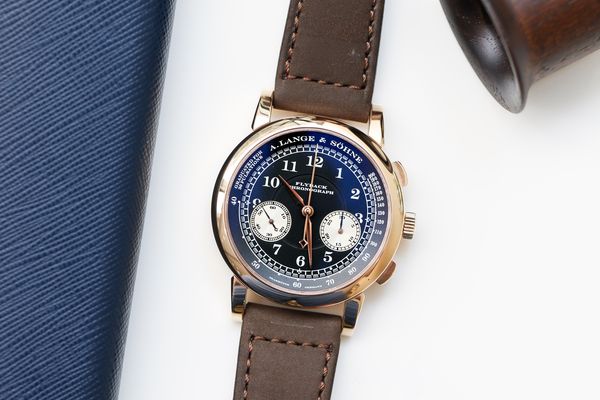
Lot 814-815-966 - The Chronos
Let us look now at some of the available chrono pieces in the HKWA: X, and start with lot 966, the most famous of them all; the A. Lange & Söhne Datograph.
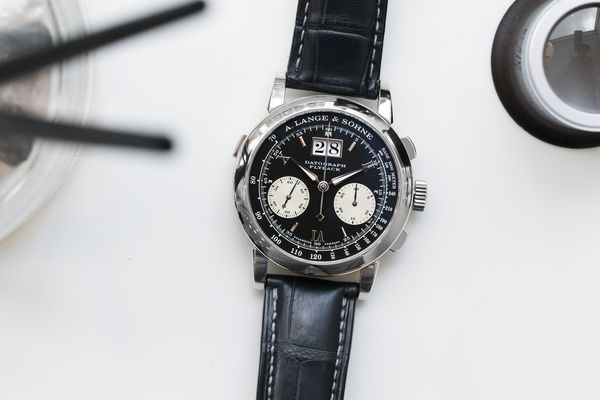
Unveiled in 1999, A. Lange & Söhne introduced yet another milestone when they released the Datograph ref. 403.035 powered by an in-house manual movement with a flyback chronograph function. A large statement at the time as there were not many options available in the market for an in-house chronograph movement; even Rolex would not come out with a Daytona powered by an in-house movement until 2000, and other major players like Patek Philippe, Vacheron Constantin and Audemars Piguet used outsourced movements which were then modified in-house.

The Datograph is considered by many enthusiasts as one of the most beautiful chronograph wristwatches manufactured in recent times. It was a game-changer for the industry and definitely brought more eyes to the small German manufacturer. The visual beauty and balance of the timepiece is undeniable; simple yet sophisticated. The reverse panda dial enhances the sub dials which were lowered to create harmony with the large date window. It is said that the three displays form an equilateral triangle. The applied hour markers are made out of white gold and surrounded by a painted tachymeter scale. The alpha hands are luminous to ensure legibility in dark environments and the platinum 39mm case is simply the perfect size for many collectors and adds to the desirability of this timepiece.
The Datograph boasts Calibre L951.1, a technically brilliant and aesthetically pleasing movement architecture comprising 405 components which is proudly displayed through the sapphire crystal caseback. The watch is equipped with a flyback chronograph complication featuring a precise jumping minutes counter. Every part of the movement is of course hand finished and flat polish can be seen on the screw head, the swan’s neck regulator, the plate over the escape wheel, and also the caps of each chronograph wheel column. Many designate the movement of the Datograph as a masterpiece. If you are skeptical about this statement, remember that Philippe Dufour himself, one of horology’s greatest living watchmakers, wears an example in pink gold and black dial. “Game recognises game” as they say.
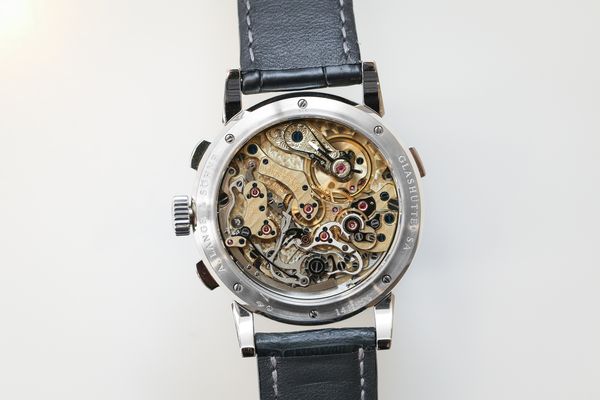
In production from 1999 to 2012, the Datograph ref. 403.035 was the longest lived of all the Datograph models but also the original model before it was upgraded with a larger case dimension as well as an additional power reserve indication at 6 o’clock. The present Datograph belongs to an early example of the famed model, encased in a 39mm diameter platinum case with the absence of the power reserve indication. Presented in excellent overall condition and accompanied by the full set of accessories, the present lot will most certainly impress discerned collectors seeking for an early example of the Datograph.

Another member of the Datograph family is represented by lot 815, the A. Lange & Söhne Datograph Perpetual.
Introduced at SIHH 2006, the Datograph Perpetual is the first wristwatch for which Lange combined a flyback chronograph function with a perpetual calendar. The timepiece retains everything we’ve come to love about the Datograph but adds here the usefulness of the perpetual calendar function.
With supreme elegance the dial displays a 60-second counter and a 30-second counter tracked by two beautifully finished blued steel hands matching harmoniously with the hue of the moon phase. Furthermore, it features the iconic large date display with indications of the day of the week, month, leap year as well as day/night. This perpetual calendar is engineered to such accuracy that it requires no adjustment until the year 2100, when a one-day correction is needed.
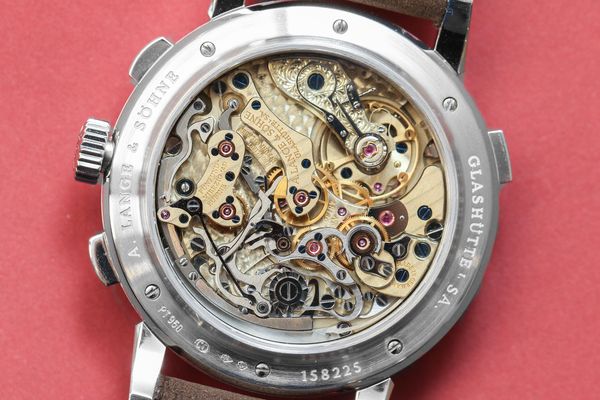
Turning the watch over, the in-house cal. L952.1 is displayed through a sapphire crystal caseback revealing its delicate hand-finished components comprising 556 individual parts. The hand-finished components are executed to the highest level displaying its signature “Glashütte” waves throughout the bridges and plates, whilst the balance cock retains its opulent engraving.
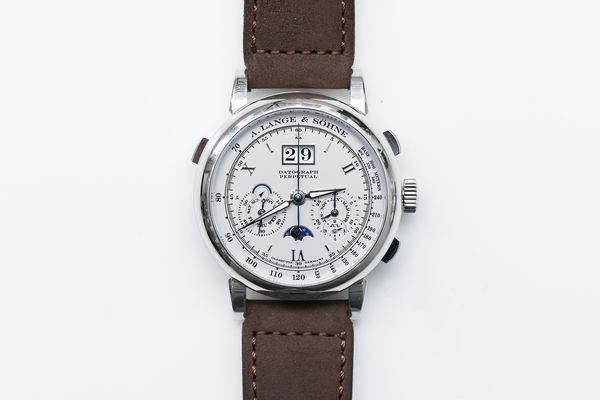
The Datograph Perpetual in platinum was discontinued in 2011, with only very few examples to have appeared in the market since. The present example in platinum is offered as a full set and in excellent overall condition with very minimal signs of use and wear.
For collectors looking at owning a more understated chronograph timepiece from the house of A. Lange & Söhne; lot 814, the 1815 Chronograph, will provide that option.
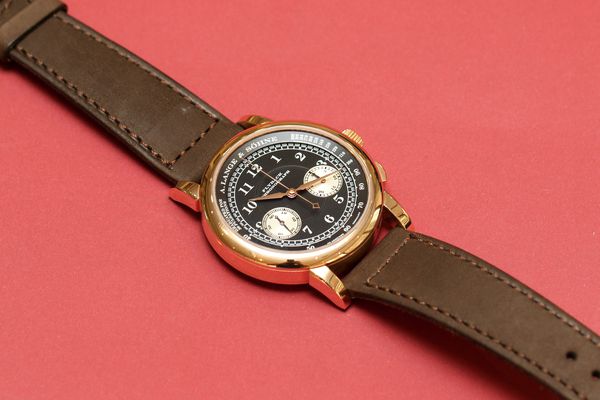
While A. Lange & Söhne’s rich history reaches back to the 19th century, when Ferdinand Adolph Lange was born in 1815, the modern rebirth of the firm only occurred 30 years ago. Since that time A. Lange & Söhne’s has become a global force and a cherished horological collectible known for their technical complications, and clean modern aesthetic.
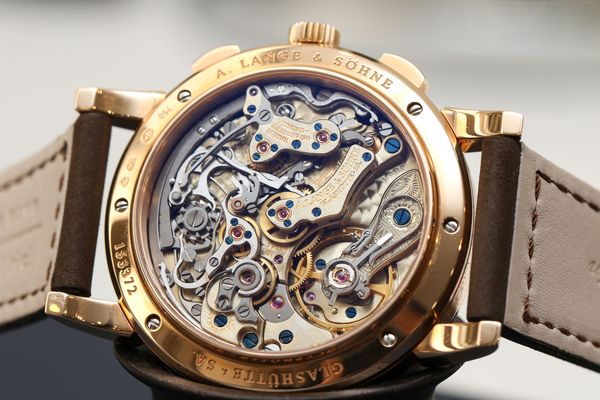
In 1995, Walter Lange presented the 1815 Collection in honour of Ferdinand’s birth in 1815, and while the watches ranged in design from time only to complications timepieces, they remain deeply traditional and are characterised by traditional hallmarks; with elements such as blued hands, the three-quarter plate made with untreated German silver, the blued screws, the screwed gold chatons, and a hand-engraved balance cock. All timepieces from the collection also feature large cases with railway-track minute scale, and Arabic numerals all reminiscent of their traditional past and fine pocket watches manufacturing.
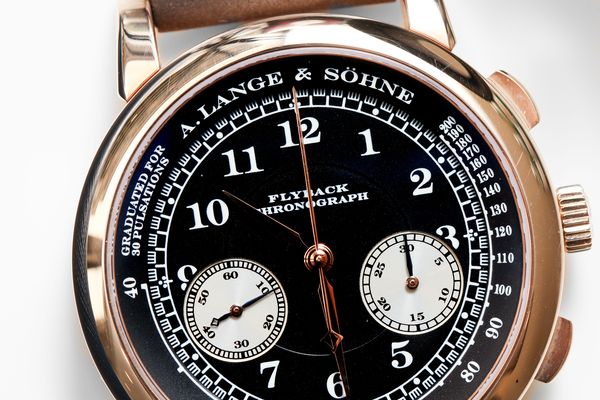
The present 1815 Chronograph in 18k pink gold is from the first generation produced between 2004 and 2008, and is a wonderful representation of the goals set forward by Walter Lange. The watch combines traditional watchmaking with 21st century engineering with the caliber 951.0, their renowned chronograph movement first used in 1999 in their Datograph model. The flyback mechanism allows the hands to zero reset for immediate new measurements. The black dial with two silvered subsidiary dials plays of the pink gold of the case and has a bold masculine aesthetic. This example is very appealing and is accompanied by its guarantee and original presentation box.
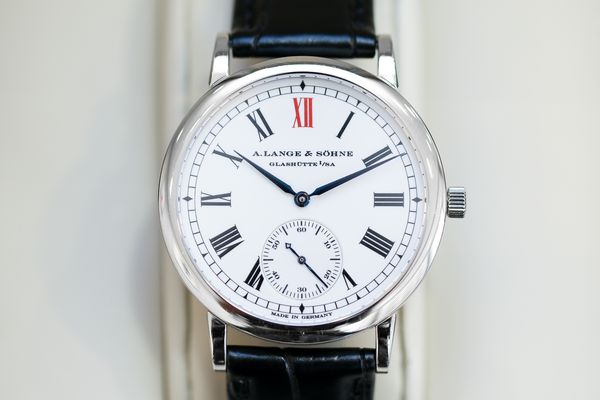
Lot 811 - Langematik Anniversary Jubilee
The ten-year anniversary of the new establishment of the manufacture was reason enough for Lange to recollect past values. In 2000, the manufacture presented the Langematik Anniversary Jubilee, as a limited edition series of 500 pieces in platinum, and with an artistically designed enamel dial.
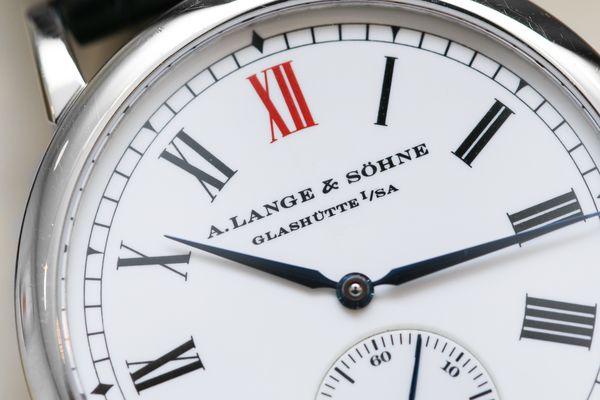
To create the “eye-perfect” enamel dial, it takes tremendous craftsmanship filled with over 30 meticulous steps with constant disappointment to finally produce the flawless enamel dial eligible to be encased in an A. Lange & Söhne case. Featured on the dial, a “chemin-de-fer” style chapter ring, a small seconds sub dial, and its iconic blued steel hands. Seemingly minor details such as the separately imprinted and separately stoved red numeral XII underscore Lange’s dedication to historic authenticity. This red-colored XII refers to old pocket watches, as the finest of them were also made with a red XII.
Beneath the dial lies the in-house caliber L 921.7 Sax-o-Mat featuring a bidirectional winding mass in 21K yellow gold and platinum as well as the signature hand-engraved balance cock.
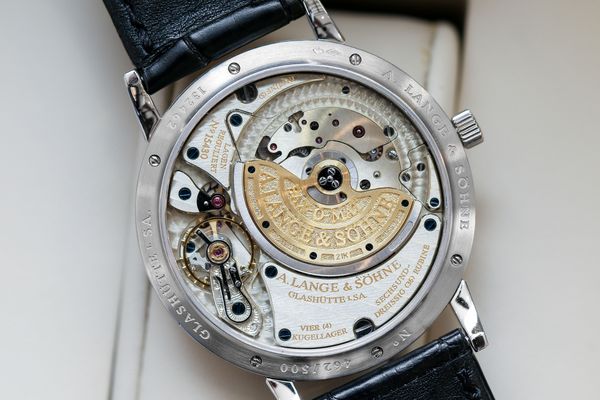
The present example numbered 462, is offered with the full set of accessories including the guarantee stamped 2002, which is correct for the reference as the production of the Langematik Anniversary Jubilee was ceased later in 2004.
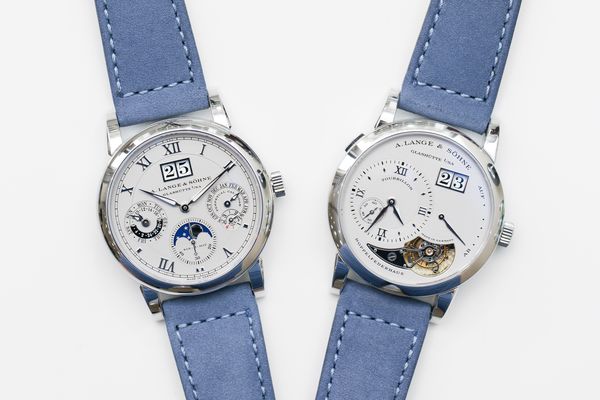
Lot 1013-1014 - Matchy matchy
We will end our preview here with two A. Lange & Söhne watches in platinum with an overall similar color scheme, which would make an interesting “set” to own if you are the type of collector who likes a certain harmony in your collection.

Released in 2001, A. Lange & Söhne’s Langematik Perpetual was at the heart of the brand's rebirth following its demise during World War II. The Saxony based manufacture sought to recapture its reputation for innovative technology and precision timekeeping.
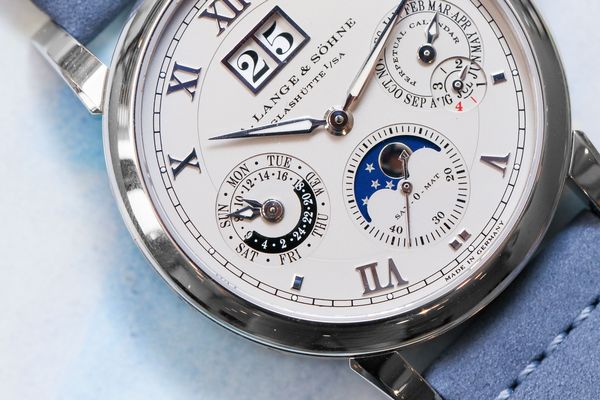
The Langematik brought the perpetual calendar moon phase from pocket watches out of their past to the forefront, but with a 21st century movement. The revolutionary timepiece featured a “zero-reset” mechanism for more accurate timing, as the crown was pulled out the constant seconds hand immediately reset to zero. Additionally, it featured a calendar correction system that adjusted the day, date and moon phase through a case corrector to easily move the three forward together in time.
This classic horological complication combines traditional watchmaking with a timepiece that adjusts every four years to compensate for the leap year. The dial features A. Lange & Söhne’s patented oversized date windows, along with subsidiary dials for month, night and day 24-hour indication and day.

It also features the Sax-o-Mat designation, found on their automatic watches, standing for SAX, Saxony the German state, 0 (zero) for “zero-reset” and MAT for automatic movement. The present example is very well preserved and a shining example of the skill and unrivalled craftsmanship that Walter Lange brought back to the frm. The perpetual calendar wristwatch is one of the most fascinating of all the complications in horology, and the Langematik is an exemplary timepiece. It is a testament to the fine art of German watchmaking.
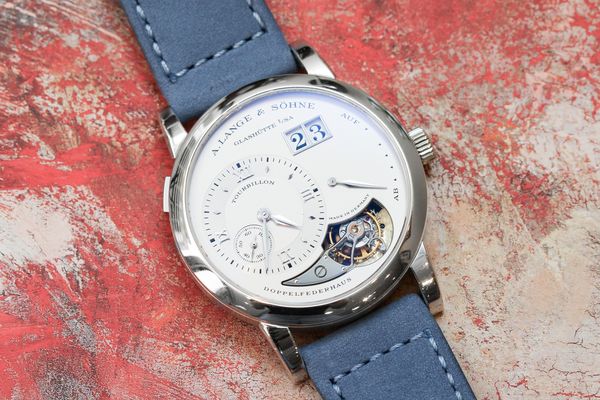
Lot 1014
Packed with the firm's heritage of fine timepieces, the Lange 1 Tourbillon is with no doubt an emblematic example of the Lange 1, still retaining its iconic asymmetric dial layout with an oversized date display. While the Lange 1 was originally released in 1994, the Lange 1 Tourbillon came about in 2000 as a limited edition of 250 pieces in 18K pink gold and 150 pieces in platinum.
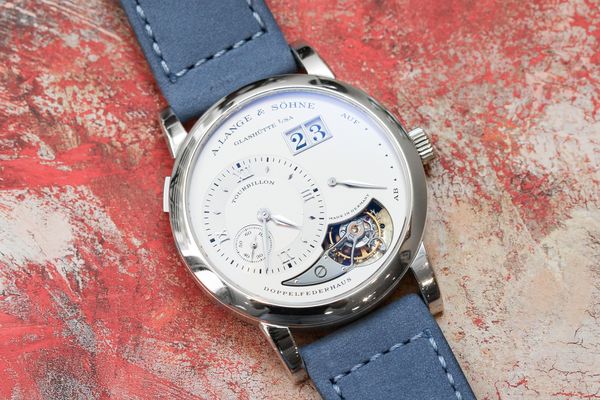
Housed inside the 38.5mm platinum case is the delicate and finely finished in-house caliber L961.1 featuring its classic three-quarter plate in German silver and its meticulous handengraved balance cock. Composed of 378 parts with 72 individual parts for the tourbillon.
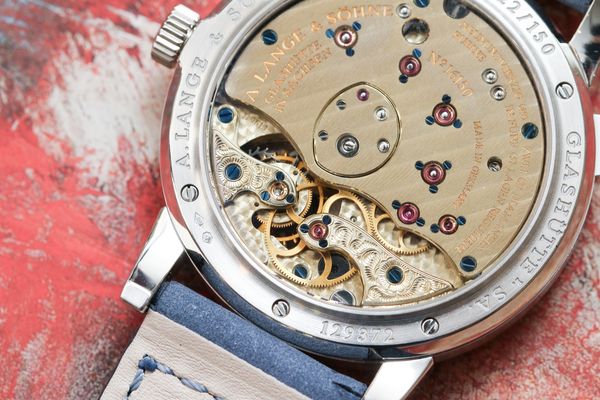
The present example numbered 122 of a limited edition of 150 pieces is presented in attractive overall condition and accompanied by the full set of accessories. Furthermore, the interesting factor of this present piece is the patina that has developed on the originally silver movement which has now developed uniformly to a much warmer gold hue creating a wonderful contrast against the desired and rare platinum case.
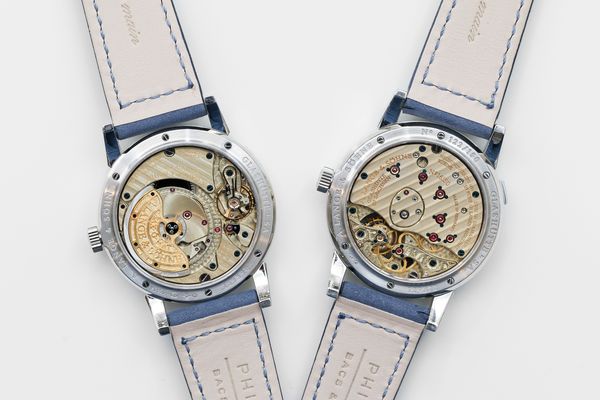
In Conclusion
Looking at auction results, more often than not, the prices realized by A. Lange & Söhne timepieces are soft. At the most recent HKWA9 for example, all watches from the German manufacture offered have been sold at prices within their estimated range. This shows that there is still plenty of room to grow. The reason why collectors aren’t focusing as much on the brand can be explained by their relative young age, the maison hasn’t even celebrated the 30year anniversary of their revival - and perhaps because their origins aren’t located in the traditional Swiss regions - yet they have produced some of the most exquisite timepieces available on the market, as this article has tried to point out, but maybe it is also a brand that simply needs time to fully comprehend and appreciate since their timepieces aren’t “loud.”
Right now, for anyone looking to purchase high horology, they provide definite opportunities for anyone to buy them at decent prices which will surely appreciate in value overtime. There are always pieces and brands which collectors can act on now before they rise up significantly and become out of reach, and A. Lange & Söhne is surely one of them.
